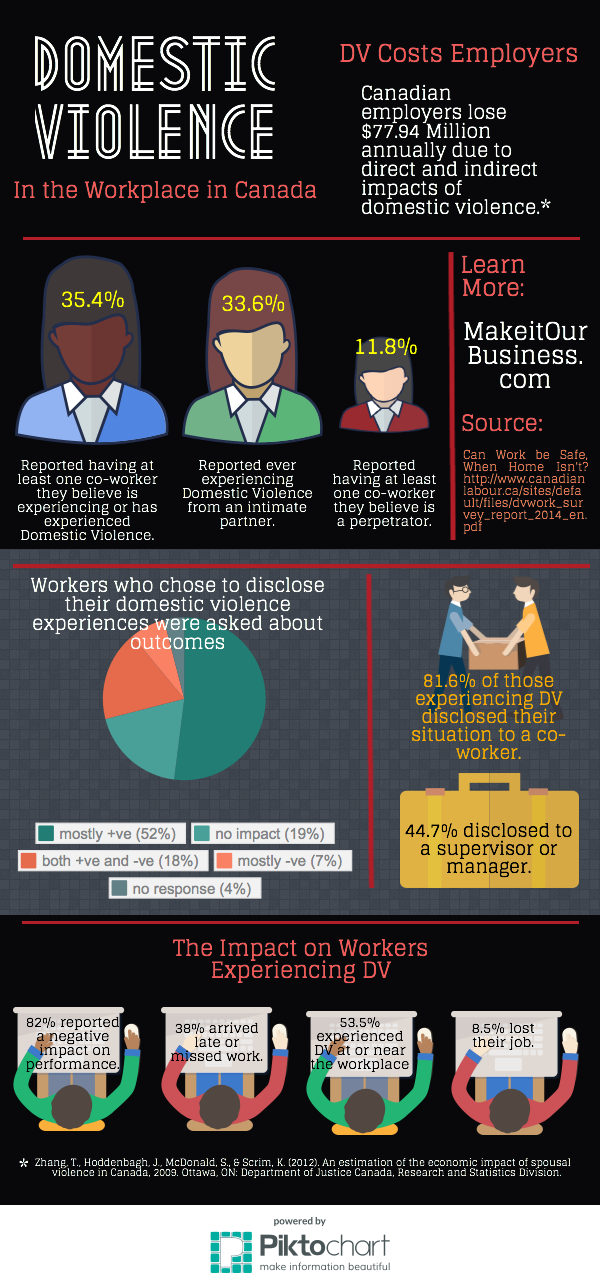Like this article? rabble is reader-supported journalism. Chip in to keep stories like these coming.
Recent research confirms that women in abusive relationships consistently state being employed is essential to their overall wellbeing. In addition to offering a brief respite from the chaos that is their lives, work provides financial security, supports physical and mental health, and provides much needed breaks from the isolation they live in. Work can also be a way to access help and services.
It’s also well documented that women experiencing intimate partner violence tend to change jobs more often, accept precarious and part-time employment, and as a result have lower incomes with few to no benefits.
Women in abusive relationships report that abusive partners continuously phone, text, or email them throughout the day. Perpetrators may stalk partners and even show up at or their work. These actions often cause women to lose their jobs. In fact, this may be the goal of abusers who ultimately want to make their partners completely dependent on them.
A 2012 survey prepared by Michele Schmidt found that 80 per cent of perpetrators enrolled in partner assault programs in Vermont reported their job performance had been negatively impacted by their own obsessive behaviours. These men cited being preoccupied with their relationship as the main reason for lack of focus and under performance.
In 2013, the Department of Justice released An Estimation of the Economic Impact of Spousal Violence in Canada, 2009. This study found that domestic violence costs Canadian employers an estimated $78 million annually. However, this fails to take into account the costs incurred by society in the forms of policing, the judicial system, correction services, health care, lost wages, damage to property, moving costs, legal costs, pain and suffering, funeral costs, social services, and the impact on children. Combined, this puts the total cost for intimate partner violence at $7.4 billion or $220 per Canadian annually. Domestic violence perpetrated against women and men were taken into account to arrive at these estimates.
Can Work Be Safe, When Home Isn’t? is a Pan-Canadian Survey on domestic violence and the workplace jointly undertaken by the Centre for Research and Education on Violence Against Women and Children and the Canadian Labour Congress. The online survey launched in December 2013 ran until June 2014. A total of 8,429 people 15 years of age and over participated. Individuals between 25 and 64 accounted for 94 per cent of respondents. Over 78 perc ent were female. 81 per cent were permanently employed and over 81 per cent were, or had been, in unionized positions mainly in education, health care and social assistance sectors.
Domestic violence was defined as any form of physical, sexual, emotional or psychological abuse. This included financial control, stalking and harassment. Opposite and same-sex intimate partners were included. Partners who were married, common law or living together were included as well as those who experienced abuse after the relationship had ended.
One-third of all respondents, male and female, reported ever experiencing domestic violence from an intimate partner. Differences in lifetime domestic violence experiences was higher for women, transgender individuals, Aboriginal people, and those with disabilities. 65 per cent of lesbian, gay or bisexual respondents reported lifetime domestic violence experiences compared with 38 per cent of women and 17 per cent of men.
Almost 54 per cent of domestic violence victims reported that at least on type of abuse happened at, or near, their work. The most common forms of abusive included phone calls, text messaging, stalking and harassment. Close to 82 per cent of victims said domestic violence negatively affected their performance because they were distracted, or felt tired, or unwell.
Over 35 per cent of respondents reported having a co-worker they believed was experiencing domestic violence. Almost 12 per cent of respondents reported having a co-worker they believed was, or had been, abusive to his or her partner. As many as 37 per cent of co-workers admitted to experiencing stress or concern because of these situations.
The research showed that 43 per cent of victims discussed their situation with a co-worker or supervisor. Women were more likely to do this than men. Generally, co-workers listened; support people helped with safety plans; while unions, supervisors and human resources often provide paid time off.
Three-quarters of all respondents thought paid leave and safety policies could reduce the impact of domestic violence on the work lives of workers.
On March 3, 2015, Manitoba amended its Employment Standards Code to include leave for victims of domestic violence, leave for serious injury or illness and extension of compassionate care leave. That means within a given 52-week period employees may chose to take a leave of up to 10 days intermittently or as one continuous period; and/or a leave of up to 17 weeks to be taken in one continuous period.
On March 8, 2016, Ontario MPP Peggy Sattler introduced a Private Member’s Bill called the Domestic and Sexual Violence Workplace Leave, Accommodation and Training Act which provides for up to 10 days of paid leave. The bill also provides additional “reasonable” unpaid leave, as well as mandatory workplace training for domestic violence and sexual violence. While the bill received all-party support, it has yet to be passed into law and implemented.
Real prevention and intervention begins when every one of us gets involved in ending intimate partner violence. Compassionate leave is one way for government, employers, co-workers and society to support those living with, and leaving, abuse. On-going education, advocacy and support in workplaces is another important piece.
Like this article? rabble is reader-supported journalism. Chip in to keep stories like these coming.



